Rebecca Eanes's Blog, page 6
June 26, 2016
Embrace the Seasons of Parenthood
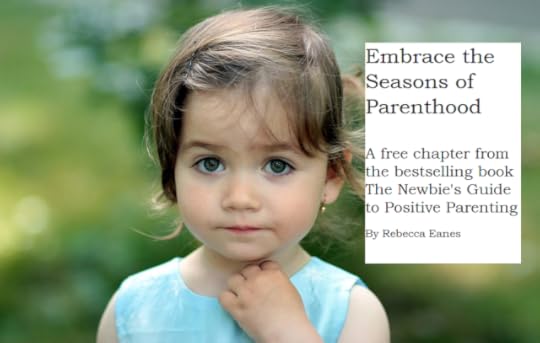
The following post is a chapter from my bestselling book, The Newbie's Guide to Positive Parenting.
****************************************************
Parenthood has many seasons. As is often our nature, we are regularly looking toward the next season rather than fully embracing and enjoying the one we're in. It's currently winter here – my least favorite season. I'm longing for the sunshine and warmth of spring. Of course, on those blistering hot summer days, I was longing for the chill of winter air. Winter always gives way to spring. Babyhood gives way to toddlerhood. Things are constantly changing, and one of the great keys to joy in life and in parenthood is learning to embrace the season that you're currently in instead of looking to the one ahead.
I remember the exhausting days when I had a two year old and a newborn. My two year old still wasn't sleeping through the night, and my newborn only slept for a couple of hours at a time. I had a toddler in my bed and a newborn in a bedside crib, and some nights I wasn't sure if I had even found sleep. I found myself doing a lot of wishing....
I wish they'd sleep through the night. I wish they'd sleep in their own room. I wish I didn't have to lie with them while they fall asleep. I wish I'd never started co-sleeping. I wish they were out of diapers. I wish I had some time for myself.
Now, my babies are big boys. They are out of my bed, out of my room, and long out of diapers. They almost never wake me at night. They sleep in their own room. They don't need me to lie down with them anymore. I give them a kiss and walk out the door – and I have lots of time for me now.
Some nights, I walk out of their room, go curl up in my bed in front of the fire with a good book and think, “Ah. This is nice.”
But then there are the other nights when I lie there and listen to them talking with each other (their room is adjacent to mine). I listen as they tell funny stories and belly laugh at each other, and their laughter makes me smile through my tears. Silent tears are falling on my pillow as I stare at my ceiling, remembering the days when they used to need me. They need me less now. And as much I used to wish for “me time” back then is as much as I'm wishing now for “baby time.” Once more, I find myself doing a lot of wishing...I wish they still needed me to lie down with them. I wish I could hold them all night like I used to. I wish we were still co-sleeping. I wish they were back in diapers. I wish I could still rock them. I wish I could go back and do it all again, and savor every moment, committing it all to memory, rather than wishing it away.
Time teaches us many lessons. Another valuable lesson time has taught me is to not sweat the small things. Children are unique individuals, yet we try to put them all on the same time line. We expect them to be crawling, walking, talking, potty trained, and reading by a certain age, and we can get our stomach in knots worrying if and why they're missing the mark.
My firstborn was potty trained by age two and a half. It took literally one day. He never looked back. He stayed dry through the night immediately. It was extremely easy. I thought I was a pro.
Son number two set me straight on the whole “pro” idea. He was well into age 4 before he decided to use the potty, and for many, many months after that, he had frequent accidents. I thought he'd go to college in diapers.
Then one day I realized I couldn't remember the last time he had an accident in his undies. Just like that, it ended. I don't know when it happened. All of that worrying was for nothing. That's how these things often go – you think the stage or season will never end, and then suddenly you realize that it has. So, when I begin to worry that my son isn't reading as well at this age as many of his peers, I stop my worrying thoughts and remind myself that he'll get it in his own time.
Childhood is not a race. Neither is parenthood. Let's stop rushing through, looking only for the next season to come, and take time to savor the one we are in. The sand is slipping through the hourglass, and there is no slowing it down. Just a blink, and suddenly there is a bit less in the top of the glass than there was before.
Time is slipping away.
Although time cannot be slowed, it can be embraced. There is delight to be found in our ordinary days. Lifelong relationships are being built in these ordinary days. Your legacy is forged in these ordinary days. While they may pass by seemingly uneventful and unimportant, there is no such thing as an unimportant day when you are shaping a child's life. Something was written on their hearts today – something important. Be intentional about what it is you are writing.
Embrace the time you have. Enjoy the season you are in.
Each season is sweet in its own way, and each one will be missed when it is gone. Don't miss the beauty of the bud while you're waiting for the blossom. Each stage of a child's life offers us a chance to know him a little better and to grow a little closer. Each stage also gives us a chance to grow into a better parent as we learn the lessons they teach us about loving unconditionally, living wholeheartedly, and giving and receiving grace.
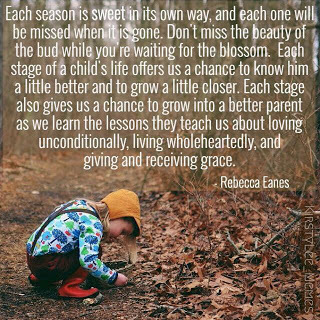 Photo credit: Gentle Parenting Memes
Photo credit: Gentle Parenting Memes*************************************************
If you enjoyed this post, check out Rebecca's new book, Positive Parenting: An Essential Guide.
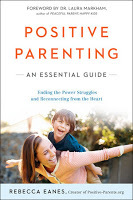
“Positive Parenting is more than a parenting book. It's a guide to human connection. Rebecca provides a roadmap for creating happy, deeply connected families where children and parents alike are able to rise to their fullest potential.” --Amy McCready, author of The “Me, Me, Me” Epidemic
To order in the USA: http://bit.ly/22ezDFN...
To order in Canada: http://amzn.to/1WBtjrF
To order in the UK: http://bit.ly/positiveparentinguk
To order from any other country: http://bit.ly/positiveparentingf
Published on June 26, 2016 12:33
June 20, 2016
When Positive Parenting Doesn't Work
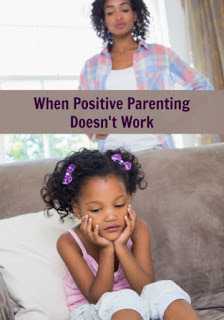 Photo credit: Creative Child Magazine
Photo credit: Creative Child MagazineRarely do I hear from parents who have tried the positive parenting approach and felt it wasn’t working. Most often, moms and dads tell me that it transformed their relationships and that their children behave better. Occasionally, though, I’ve heard “I’m doing it, but it’s not working!” It’s impossible to tell what is causing the problem because every child, parent, and household is so unique. However, there are six common circumstances that might cause positive parenting attempts to feel like a failure.
You’re being permissive.
Connected relationships are the foundation of positive parenting. When a child has a secure attachment with his caregiver, he is more cooperative. As parents, we have the most influence on children when we have their hearts . This doesn’t mean, however, that we tiptoe around our kids, afraid to set any limit that would cause them to be upset with us for fear of damaging the relationship.
Positive parents are still very much in the leadership role and we must set limits and maintain boundaries.
So, if you’re finding that you’re letting your child overstep boundaries just to avoid conflict or confrontation, it’s likely that you’re being too permissive. Work on being firm and kind at the same time. Envision yourself as a calm and capable pilot. A little turbulence doesn’t fluster you. If you’re unsure what to do when your kids overstep their boundaries, try these positive parenting alternatives to time-out that work.
You’re not living the messages you’re preaching.
Who we are to our kids matters more than what we say. Children watch us – how we handle ourselves, how we react, how we behave – and they imitate what they see. The old “do as I say, not as I do” adage doesn’t work in positive parenting because it requires escalating punishments to make kids comply when their natural inclination is to do what their parents do. To have the greatest positive impact, make sure your own behavior is in line with the messages and values you want your kids to live by.
You and your partner are sending conflicting messages.
It’s confusing for kids when one parent is trying to be positive while the other is punitive. For positive parenting to work best, both parents need to come to an agreement that this is best for their family and commit to practicing it wholeheartedly. My new book, Positive Parenting: An Essential Guide , will help you and your partner work through your differences and get on the same page.
There’s a strong negative influence in the child’s life.
It could be a friend to whom your child has an attachment, something from the Internet, or even a TV show. I once had to cut out a certain cartoon until my children were older because they mimicked things the cartoon characters said that sounded rude.
Children are great imitators.
If they see and hear their friends exhibiting a certain behavior, they may try it out, too. Be aware of who and what is influencing your child, set clear limits, and maintain your boundaries. In my opinion, losing television privileges isn’t an arbitrary punishment if the television is what’s causing the problem. It’s a logical solution to the problem.
Your expectations are too high.
If you’ve recently transitioned to positive parenting , it will likely take some time for everyone to adjust to the changes. Don’t give up too soon. You also have to ask yourself if your expectations are reasonable for your child’s age and circumstances. Is it possible that you’re comparing yourself or your children to others or setting a standard of perfection that isn’t attainable?
The relationship needs work.
There may be a disconnect present in your relationship. Don’t worry, this doesn’t mean you’ve done something terribly wrong. If your child seems defiant or frequently breaks rules or doesn’t listen, that’s a cue that you should spend more time connecting with her. Here are 10 ways to connect with your child .
We all hit roadblocks in this parenting journey. If it seems like positive parenting isn’t working for you right now, don’t give up. Being receptive and open to the possibilities of improvement is half the work!
**This post was originally published at Creative Child Magazine.

Find more of my Creative Child articles here.
**********************************************************************
Positive Parenting: An Essential Guide

“Positive Parenting is more than a parenting book. It's a guide to human connection. Rebecca provides a roadmap for creating happy, deeply connected families where children and parents alike are able to rise to their fullest potential.” --Amy McCready, author of The “Me, Me, Me” Epidemic
To order in the USA: http://bit.ly/22ezDFN...
To order in Canada: http://amzn.to/1WBtjrF
To order in the UK: http://bit.ly/positiveparentinguk
To order from any other country: http://bit.ly/positiveparentingf
Published on June 20, 2016 16:01
June 17, 2016
9 Things Every Parent with an Anxious Child Should Try
9 Things Every Parent with an Anxious Child Should Try
By Renee Jain, Chief Storyteller at GoZen.com
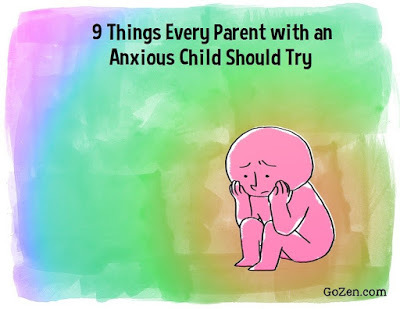
As all the kids line up to go to school, your son, Timmy, turns to you and says, "I don't want to take the bus. My stomach hurts. Please don't make me go." You cringe and think, Here we go again. What should be a simple morning routine explodes into a daunting challenge.
You look at Timmy and see genuine terror. You want to comfort him. You want to ease the excessive worry that's become part and parcel of his everyday life. First, you try logic. "Timmy, we walk an extra four blocks to catch this bus because this driver has an accident-free driving record!" He doesn't budge.
You provide reassurance. "I promise you'll be OK. Timmy, look at me... you trust me, right?" Timmy nods. A few seconds later he whispers, "Please don't make me go."
You resort to anger: "Timothy Christopher, you will get on this bus RIGHT NOW, or there will be serious consequences. No iPad for one week!" He looks at you as if you're making him walk the plank. He climbs onto the bus, defeated. You feel terrible.
If any of this sounds familiar, know you are not alone. Most parents would move mountains to ease their child's pain. Parents of kids with anxiety would move planets and stars as well. It hurts to watch your child worry over situations that, frankly, don't seem that scary. Here's the thing: To your child's mind, these situations are genuinely threatening. And even perceived threats can create a real nervous system response. We call this response anxiety and I know it well.
I'd spent the better part of my childhood covering up a persistent, overwhelming feeling of worry until, finally, in my early twenties, I decided to seek out a solution. What I've learned over the last two decades is that many people suffer from debilitating worry. In fact, 40 million American adults, as well as 1 in 8 children, suffer from anxiety. Many kids miss school, social activities and a good night's rest just from the worried thoughts in their head. Many parents suffer from frustration and a feeling of helplessness when they witness their child in this state day in, day out.
What I also learned is that while there is no one-size-fits-all solution for anxiety, there are a plethora of great research-based techniques that can help manage it -- many of which are simple to learn. WAIT! Why didn't my parents know about this? Why didn't I know about it? Why don't they teach these skills in school?
I wish I could go back in time and teach the younger version of myself how to cope, but of course, that's not possible. What is possible is to try to reach as many kids and parents as possible with these coping skills. What is possible is to teach kids how to go beyond just surviving to really finding meaning, purpose and happiness in their lives. To this end, I created an anxiety relief program for kids called GoZen! Here are 9 ideas straight from that program that parents of anxious children can try right away:
1. Stop Reassuring Your Child
Your child worries. You know there is nothing to worry about, so you say, "Trust me. There's nothing to worry about." Done and done, right? We all wish it were that simple. Why does your reassurance fall on deaf ears? It's actually not the ears causing the issue. Your anxious child desperately wants to listen to you, but the brain won't let it happen. During periods of anxiety, there is a rapid dump of chemicals and mental transitions executed in your body for survival. One by-product is that the prefrontal cortex -- or more logical part of the brain -- gets put on hold while the more automated emotional brain takes over. In other words, it is really hard for your child to think clearly, use logic or even remember how to complete basic tasks. What should you do instead of trying to rationalize the worry away? Try something I call the FEEL method:
• Freeze -- pause and take some deep breaths with your child. Deep breathing can help reverse the nervous system response.
• Empathize -- anxiety is scary. Your child wants to know that you get it.
• Evaluate -- once your child is calm, it's time to figure out possible solutions.
• Let Go - Let go of your guilt; you are an amazing parent giving your child the tools to manage their worry.
2. Highlight Why Worrying is Good
Remember, anxiety is tough enough without a child believing that Something is wrong with me. Many kids even develop anxiety about having anxiety. Teach your kids that worrying does, in fact, have a purpose.
When our ancestors were hunting and gathering food there was danger in the environment, and being worried helped them avoid attacks from the saber-toothed cat lurking in the bush. In modern times, we don't have a need to run from predators, but we are left with an evolutionary imprint that protects us: worry.
Worry is a protection mechanism. Worry rings an alarm in our system and helps us survive danger. Teach your kids that worry is perfectly normal, it can help protect us, and everyone experiences it from time to time. Sometimes our system sets off false alarms, but this type of worry (anxiety) can be put in check with some simple techniques.
3. Bring Your Child's Worry to Life
As you probably know, ignoring anxiety doesn't help. But bringing worry to life and talking about it like a real person can. Create a worry character for your child. In GoZen!, we created Widdle the Worrier. Widdle personifies anxiety. Widdle lives in the old brain that is responsible for protecting us when we're in danger. Of course, sometimes Widdle gets a little out of control and when that happens, we have to talk some sense into Widdle. You can use this same idea with a stuffed animal or even role-playing at home.
Personifying worry or creating a character has multiple benefits. It can help demystify this scary physical response children experience when they worry. It can reactivate the logical brain, and it's a tool your children can use on their own at any time.
Have an anxious child? Join us for a LIVE, FREE masterclass: 9 Things Every Parent with an Anxious Child Should Try, Thursday, June 23rd @ 4pm EDT - Grab your spot now!
4. Teach Your Child to Be a Thought Detective
Remember, worry is the brain's way of protecting us from danger. To make sure we're really paying attention, the mind often exaggerates the object of the worry (e.g., mistaking a stick for a snake). You may have heard that teaching your children to think more positively could calm their worries. But the best remedy for distorted thinking is not positive thinking; it's accurate thinking. Try a method we call the 3Cs:
• Catch your thoughts: Imagine every thought you have floats above your head in a bubble (like what you see in comic strips). Now, catch one of the worried thoughts like "No one at school likes me."
• Collect evidence: Next, collect evidence to support or negate this thought. Teach your child not to make judgments about what to worry about based only on feelings. Feelings are not facts. (Supporting evidence: "I had a hard time finding someone to sit with at lunch yesterday." Negating evidence: "Sherry and I do homework together--she's a friend of mine.")
• Challenge your thoughts: The best (and most entertaining) way to do this is to teach your children to have a debate within themselves.
5. Allow Them to Worry
As you know, telling your children not to worry won't prevent them from doing so. If your children could simply shove their feelings away, they would. But allowing your children to worry openly, in limited doses, can be helpful. Create a daily ritual called "Worry Time" that lasts 10 to 15 minutes. During this ritual encourage your children to release all their worries in writing. You can make the activity fun by decorating a worry box. During worry time there are no rules on what constitutes a valid worry -- anything goes. When the time is up, close the box and say good-bye to the worries for the day.
6. Help Them Go from What If to What Is
You may not know this, but humans are capable of time travel. In fact, mentally we spend a lot of time in the future. For someone experiencing anxiety, this type of mental time travel can exacerbate the worry. A typical time traveler asks what-if questions: "What if I can't open my locker and I miss class?" "What if Suzy doesn't talk to me today?"Research shows that coming back to the present can help alleviate this tendency. One effective method of doing this is to practice mindfulness exercises. Mindfulness brings a child from what if to what is. To do this, help your child simply focus on their breath for a few minutes.
Have an anxious child? Join us for a LIVE, FREE masterclass: 9 Things Every Parent with an Anxious Child Should Try, Thursday, June 23rd @ 4pm EDT - Grab your spot now!
7. Avoid Avoiding Everything that Causes Anxiety
Do your children want to avoid social events, dogs, school, planes or basically any situation that causes anxiety? As a parent, do you help them do so? Of course! This is natural. The flight part of the flight-fight-freeze response urges your children to escape the threatening situation. Unfortunately, in the long run, avoidance makes anxiety worse.
So what's the alternative? Try a method we call laddering. Kids who are able to manage their worry break it down into manageable chunks. Laddering uses this chunking concept and gradual exposure to reach a goal.
Let's say your child is afraid of sitting on the swings in the park. Instead of avoiding this activity, create mini-goals to get closer to the bigger goal (e.g., go to the edge of the park, then walk into the park, go to the swings, and, finally, get on a swing). You can use each step until the exposure becomes too easy; that's when you know it's time to move to the next rung on the ladder.
8. Help Them Work Through a Checklist
What do trained pilots do when they face an emergency? They don't wing it (no pun intended!); they refer to their emergency checklists. Even with years of training, every pilot works through a checklist because, when in danger, sometimes it's hard to think clearly.When kids face anxiety they feel the same way. Why not create a checklist so they have a step-by-step method to calm down? What do you want them to do when they first feel anxiety coming on? If breathing helps them, then the first step is to pause and breathe. Next, they can evaluate the situation. In the end, you can create a hard copy checklist for your child to refer to when they feel anxious.
9. Practice Self-Compassion
Watching your child suffer from anxiety can be painful, frustrating, and confusing. There is not one parent that hasn't wondered at one time or another if they are the cause of their child's anxiety. Here's the thing, research shows that anxiety is often the result of multiple factors (i.e., genes, brain physiology, temperament, environmental factors, past traumatic events, etc.). Please keep in mind, you did not cause your child's anxiety, but you can help them overcome it.
Toward the goal of a healthier life for the whole family, practice self-compassion. Remember, you're not alone, and you're not to blame. It's time to let go of debilitating self-criticism and forgive yourself. Love yourself. You are your child's champion.
Have an anxious child? Take your learning much deeper and join us for a LIVE, FREE masterclass: 9 Things Every Parent with an Anxious Child Should Try, Thursday, June 23rd @ 4pm EDT - Grab your spot now!
Bio:
 Renee Jain is an award-winning tech entrepreneur turned speaker and certified life coach. She holds a masters in applied positive psychology from the University of Pennsylvania. Renee’s passion is taking research-based concepts and transforming them into fun and digestible learning modules. Renee teaches anxious children how to manage stress and worry through her innovative GoZen! Anxiety Relief Programs for Kids.
Renee Jain is an award-winning tech entrepreneur turned speaker and certified life coach. She holds a masters in applied positive psychology from the University of Pennsylvania. Renee’s passion is taking research-based concepts and transforming them into fun and digestible learning modules. Renee teaches anxious children how to manage stress and worry through her innovative GoZen! Anxiety Relief Programs for Kids.
By Renee Jain, Chief Storyteller at GoZen.com

As all the kids line up to go to school, your son, Timmy, turns to you and says, "I don't want to take the bus. My stomach hurts. Please don't make me go." You cringe and think, Here we go again. What should be a simple morning routine explodes into a daunting challenge.
You look at Timmy and see genuine terror. You want to comfort him. You want to ease the excessive worry that's become part and parcel of his everyday life. First, you try logic. "Timmy, we walk an extra four blocks to catch this bus because this driver has an accident-free driving record!" He doesn't budge.
You provide reassurance. "I promise you'll be OK. Timmy, look at me... you trust me, right?" Timmy nods. A few seconds later he whispers, "Please don't make me go."
You resort to anger: "Timothy Christopher, you will get on this bus RIGHT NOW, or there will be serious consequences. No iPad for one week!" He looks at you as if you're making him walk the plank. He climbs onto the bus, defeated. You feel terrible.
If any of this sounds familiar, know you are not alone. Most parents would move mountains to ease their child's pain. Parents of kids with anxiety would move planets and stars as well. It hurts to watch your child worry over situations that, frankly, don't seem that scary. Here's the thing: To your child's mind, these situations are genuinely threatening. And even perceived threats can create a real nervous system response. We call this response anxiety and I know it well.
I'd spent the better part of my childhood covering up a persistent, overwhelming feeling of worry until, finally, in my early twenties, I decided to seek out a solution. What I've learned over the last two decades is that many people suffer from debilitating worry. In fact, 40 million American adults, as well as 1 in 8 children, suffer from anxiety. Many kids miss school, social activities and a good night's rest just from the worried thoughts in their head. Many parents suffer from frustration and a feeling of helplessness when they witness their child in this state day in, day out.
What I also learned is that while there is no one-size-fits-all solution for anxiety, there are a plethora of great research-based techniques that can help manage it -- many of which are simple to learn. WAIT! Why didn't my parents know about this? Why didn't I know about it? Why don't they teach these skills in school?
I wish I could go back in time and teach the younger version of myself how to cope, but of course, that's not possible. What is possible is to try to reach as many kids and parents as possible with these coping skills. What is possible is to teach kids how to go beyond just surviving to really finding meaning, purpose and happiness in their lives. To this end, I created an anxiety relief program for kids called GoZen! Here are 9 ideas straight from that program that parents of anxious children can try right away:
1. Stop Reassuring Your Child
Your child worries. You know there is nothing to worry about, so you say, "Trust me. There's nothing to worry about." Done and done, right? We all wish it were that simple. Why does your reassurance fall on deaf ears? It's actually not the ears causing the issue. Your anxious child desperately wants to listen to you, but the brain won't let it happen. During periods of anxiety, there is a rapid dump of chemicals and mental transitions executed in your body for survival. One by-product is that the prefrontal cortex -- or more logical part of the brain -- gets put on hold while the more automated emotional brain takes over. In other words, it is really hard for your child to think clearly, use logic or even remember how to complete basic tasks. What should you do instead of trying to rationalize the worry away? Try something I call the FEEL method:
• Freeze -- pause and take some deep breaths with your child. Deep breathing can help reverse the nervous system response.
• Empathize -- anxiety is scary. Your child wants to know that you get it.
• Evaluate -- once your child is calm, it's time to figure out possible solutions.
• Let Go - Let go of your guilt; you are an amazing parent giving your child the tools to manage their worry.
2. Highlight Why Worrying is Good
Remember, anxiety is tough enough without a child believing that Something is wrong with me. Many kids even develop anxiety about having anxiety. Teach your kids that worrying does, in fact, have a purpose.
When our ancestors were hunting and gathering food there was danger in the environment, and being worried helped them avoid attacks from the saber-toothed cat lurking in the bush. In modern times, we don't have a need to run from predators, but we are left with an evolutionary imprint that protects us: worry.
Worry is a protection mechanism. Worry rings an alarm in our system and helps us survive danger. Teach your kids that worry is perfectly normal, it can help protect us, and everyone experiences it from time to time. Sometimes our system sets off false alarms, but this type of worry (anxiety) can be put in check with some simple techniques.
3. Bring Your Child's Worry to Life
As you probably know, ignoring anxiety doesn't help. But bringing worry to life and talking about it like a real person can. Create a worry character for your child. In GoZen!, we created Widdle the Worrier. Widdle personifies anxiety. Widdle lives in the old brain that is responsible for protecting us when we're in danger. Of course, sometimes Widdle gets a little out of control and when that happens, we have to talk some sense into Widdle. You can use this same idea with a stuffed animal or even role-playing at home.
Personifying worry or creating a character has multiple benefits. It can help demystify this scary physical response children experience when they worry. It can reactivate the logical brain, and it's a tool your children can use on their own at any time.
Have an anxious child? Join us for a LIVE, FREE masterclass: 9 Things Every Parent with an Anxious Child Should Try, Thursday, June 23rd @ 4pm EDT - Grab your spot now!
4. Teach Your Child to Be a Thought Detective
Remember, worry is the brain's way of protecting us from danger. To make sure we're really paying attention, the mind often exaggerates the object of the worry (e.g., mistaking a stick for a snake). You may have heard that teaching your children to think more positively could calm their worries. But the best remedy for distorted thinking is not positive thinking; it's accurate thinking. Try a method we call the 3Cs:
• Catch your thoughts: Imagine every thought you have floats above your head in a bubble (like what you see in comic strips). Now, catch one of the worried thoughts like "No one at school likes me."
• Collect evidence: Next, collect evidence to support or negate this thought. Teach your child not to make judgments about what to worry about based only on feelings. Feelings are not facts. (Supporting evidence: "I had a hard time finding someone to sit with at lunch yesterday." Negating evidence: "Sherry and I do homework together--she's a friend of mine.")
• Challenge your thoughts: The best (and most entertaining) way to do this is to teach your children to have a debate within themselves.
5. Allow Them to Worry
As you know, telling your children not to worry won't prevent them from doing so. If your children could simply shove their feelings away, they would. But allowing your children to worry openly, in limited doses, can be helpful. Create a daily ritual called "Worry Time" that lasts 10 to 15 minutes. During this ritual encourage your children to release all their worries in writing. You can make the activity fun by decorating a worry box. During worry time there are no rules on what constitutes a valid worry -- anything goes. When the time is up, close the box and say good-bye to the worries for the day.
6. Help Them Go from What If to What Is
You may not know this, but humans are capable of time travel. In fact, mentally we spend a lot of time in the future. For someone experiencing anxiety, this type of mental time travel can exacerbate the worry. A typical time traveler asks what-if questions: "What if I can't open my locker and I miss class?" "What if Suzy doesn't talk to me today?"Research shows that coming back to the present can help alleviate this tendency. One effective method of doing this is to practice mindfulness exercises. Mindfulness brings a child from what if to what is. To do this, help your child simply focus on their breath for a few minutes.
Have an anxious child? Join us for a LIVE, FREE masterclass: 9 Things Every Parent with an Anxious Child Should Try, Thursday, June 23rd @ 4pm EDT - Grab your spot now!
7. Avoid Avoiding Everything that Causes Anxiety
Do your children want to avoid social events, dogs, school, planes or basically any situation that causes anxiety? As a parent, do you help them do so? Of course! This is natural. The flight part of the flight-fight-freeze response urges your children to escape the threatening situation. Unfortunately, in the long run, avoidance makes anxiety worse.
So what's the alternative? Try a method we call laddering. Kids who are able to manage their worry break it down into manageable chunks. Laddering uses this chunking concept and gradual exposure to reach a goal.
Let's say your child is afraid of sitting on the swings in the park. Instead of avoiding this activity, create mini-goals to get closer to the bigger goal (e.g., go to the edge of the park, then walk into the park, go to the swings, and, finally, get on a swing). You can use each step until the exposure becomes too easy; that's when you know it's time to move to the next rung on the ladder.
8. Help Them Work Through a Checklist
What do trained pilots do when they face an emergency? They don't wing it (no pun intended!); they refer to their emergency checklists. Even with years of training, every pilot works through a checklist because, when in danger, sometimes it's hard to think clearly.When kids face anxiety they feel the same way. Why not create a checklist so they have a step-by-step method to calm down? What do you want them to do when they first feel anxiety coming on? If breathing helps them, then the first step is to pause and breathe. Next, they can evaluate the situation. In the end, you can create a hard copy checklist for your child to refer to when they feel anxious.
9. Practice Self-Compassion
Watching your child suffer from anxiety can be painful, frustrating, and confusing. There is not one parent that hasn't wondered at one time or another if they are the cause of their child's anxiety. Here's the thing, research shows that anxiety is often the result of multiple factors (i.e., genes, brain physiology, temperament, environmental factors, past traumatic events, etc.). Please keep in mind, you did not cause your child's anxiety, but you can help them overcome it.
Toward the goal of a healthier life for the whole family, practice self-compassion. Remember, you're not alone, and you're not to blame. It's time to let go of debilitating self-criticism and forgive yourself. Love yourself. You are your child's champion.
Have an anxious child? Take your learning much deeper and join us for a LIVE, FREE masterclass: 9 Things Every Parent with an Anxious Child Should Try, Thursday, June 23rd @ 4pm EDT - Grab your spot now!
Bio:
 Renee Jain is an award-winning tech entrepreneur turned speaker and certified life coach. She holds a masters in applied positive psychology from the University of Pennsylvania. Renee’s passion is taking research-based concepts and transforming them into fun and digestible learning modules. Renee teaches anxious children how to manage stress and worry through her innovative GoZen! Anxiety Relief Programs for Kids.
Renee Jain is an award-winning tech entrepreneur turned speaker and certified life coach. She holds a masters in applied positive psychology from the University of Pennsylvania. Renee’s passion is taking research-based concepts and transforming them into fun and digestible learning modules. Renee teaches anxious children how to manage stress and worry through her innovative GoZen! Anxiety Relief Programs for Kids.
Published on June 17, 2016 20:22
May 20, 2016
Punishing Children for Being Human
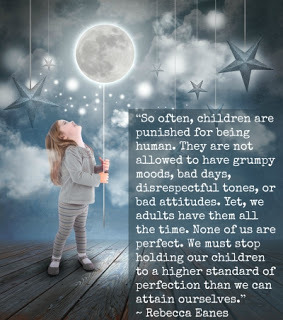
There’s an excerpt from my book, The Newbie’s Guide to Positive Parenting , that has been around the world. It is my most widely seen quote to date, and also happens to be the most controversial because people misunderstand it without its surrounding context.
“So often, children are punished for being human. They are not allowed to have grumpy moods, bad days, disrespectful tones, or bad attitudes. Yet, we adults have them all the time. None of us are perfect. We must stop holding our children to a higher standard of perfection than we can attain ourselves.” Many parents understand the quote’s meaning, which is children aren’t perfect and that we often expect much better behavior and more self-control from our children than what even we, as grown-ups, are able to demonstrate. They have expressed wholehearted agreement and acknowledged that they, too, have been guilty of holding their children to a higher standard than they hold themselves to.
Still, there are many others who have misunderstood it to mean that we shouldn’t hold children accountable for their behavior and that we should disregard all disrespect and bad attitudes, which obviously isn’t what I’m suggesting at all.
To give context to this quote, here is what I say in my book directly afterward: “Of course, I’m not saying to always “let them by with it” just because they’re human. Teach them better! Teach them it’s not okay to project a bad mood on those around you. Teach them how to handle frustration, anger, fear, sadness, and disappointment. Teach them that it’s not acceptable to be rude to people.
Hold them to a high standard! But please, hold yourself to one, too.
Don’t project your bad moods. Learn how to handle your frustration, anger, fear, sadness, or disappointment. Don’t be rude to them. We all need high standards, and do you know what else we all need? A little grace. You know better, but sometimes you have a bad day and say something that isn’t nice, or you slam a door, or you yell at your kids.
We aren’t robots. Sometimes life is just plain hard, and we need a break, not a lecture. We need a hug, not a scornful look. We know we did wrong, but we’re having a hard time. We just need grace. The same goes for our children.”
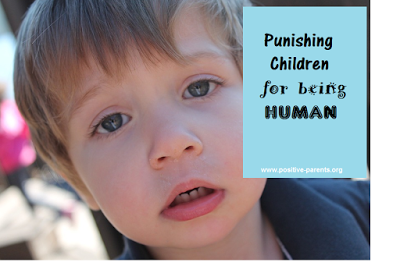
Here’s a good exercise:
Listen to yourself and the other adults in the home today and notice whether anything you say or do would land you in trouble if you were the child.
Did you ignore your toddler while he was talking to you?
Did you yell at someone?
Have you spoken with a tone of disrespect?
Has your partner?
Did you slam a door, roll your eyes, or huff at another request?
It’s an eye opening exercise because we realize that most of us do at least one thing that we would scold our child for doing.
We have reasons, of course. We are stressed because of work. We’re sleep-deprived because of the baby. We are sick or achy or hormonal. We are good people who are trying hard and who occasionally mess up. We tend to look at the reasons behind our own behavior and give ourselves a little grace for making mistakes.
But when our kids do it, we don’t look at the reasons behind it. We see them as bratty or naughty, and we skip straight to correction. It’s okay for us to be human, but we expect better of our kids, and that’s not fair.
If I can’t keep my temper in check at all times, I don’t expect my children to have perfect emotional control. If I can’t watch my tone and speak with a kind voice always, how can I expect my little ones to manage this?
We expect these little children with their underdeveloped brains and limited life experiences to behave better than grown men and women. And if you don’t believe me, listen to the next presidential debate or spend some time scrolling your social media newsfeeds.
I’m in full support of high standards. I think we ought to expect our children to be kind, thoughtful, and well-mannered. I think we ought to live up to our own expectations, too.
It is, of course, extremely important to teach our children that it is never good to be rude or disrespectful. Children, and all humans, should be held accountable for their actions. Failing to correct our kids when they need correction is permissiveness, and that isn't positive parenting. It isn't parenting at all. They must be taught to do better, and we must do better, collectively, as well. We adults must set the standard high and lead the way. We should also remember, though, that sometimes compassion is the best teacher. Sometimes grace is the solution.
I am a good person, but I also know that I am flawed. I am an imperfect human that messes up despite my best efforts, and I know that my little imperfect humans are going to mess up, too. That doesn’t make their poor choices “okay,” but it makes them understandable and gives us all a chance to grow and improve. Sometimes correction is absolutely necessary to be sure. And sometimes we just need a little grace.
**This post was originally published at Creative Child Magazine. Find more of my Creative Child articles here.
**********************************************************************
Positive Parenting: An Essential Guide

“Positive Parenting is more than a parenting book. It's a guide to human connection. Rebecca provides a roadmap for creating happy, deeply connected families where children and parents alike are able to rise to their fullest potential.” --Amy McCready, author of The “Me, Me, Me” Epidemic
To order in the USA: http://bit.ly/22ezDFN...
To order in Canada: http://amzn.to/1WBtjrF
To order in the UK: http://bit.ly/positiveparentinguk
To order from any other country: http://bit.ly/positiveparentingf
Published on May 20, 2016 13:34
May 13, 2016
26 Phrases to Calm an Angry Child
26 Phrases to Calm an Angry Child
Written by Renee Jain, Chief Storyteller at GoZen! Anxiety Relief for Kids
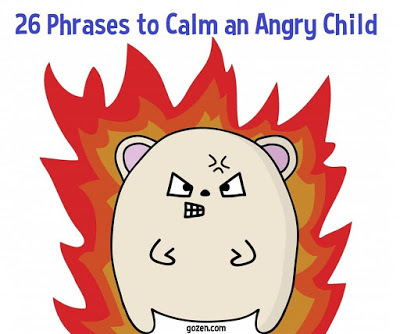
Whether your child has a slow-burning fuse or explodes like a firecracker at the slightest provocation, every child can benefit from anger management skills. As parents, we lay the foundation for this skill set by governing our own emotions in the face an angry outburst. Next time you are dealing with a tantrum from a toddler, or cold shoulder from a teen, put your best foot forward by trying one of these 26 phrases:
Instead of: Stop throwing things!
Try this: When you throw your toys, I think you don't like playing with them. Is that what’s going on?
This speaker/listener technique is designed to help communicate feelings in a non-confrontational manner. Not only does this keep the lines of communication open, you are modeling how to phrase a situation from your perspective, which in turn gives your child a chance to rephrase events in his (her) perspective.
Instead of: Big kids don't do this!
Try this: Big kids and even grown ups sometimes have big feelings. It’s OK, these feeling will pass.
Let's be honest. The older your kids get, the bigger the problems they face, the bigger the feelings they have. Telling them that big kids don't experience anger, frustration, or anxiety is simply untrue. It also encourages children to avoid or quash emotions and prevents processing them in a healthy manner.
Instead of: Don't be angry!
Try this: I get angry too sometimes. Let's try our warrior cry to get those angry feelings in check.
A recent study reveals that yelling when we are physically hurt can actually interrupt pain messages being sent to the brain. Although your child may not be in pain per se, a warrior cry can work to release angry energy in a playful manner. Choose a warrior cry or mantra together with your child (think of William Wallace from the movie Brave Heart screaming “Freeeeeeeeeeeeeeeeedom!”).
Instead of: Don't you dare hit!
Try this: It's OK to be angry, but I won't let you hit. We need to keep everyone safe.
This gets the message firmly across that the emotion is okay, but the action is not. Separating the two will help your child learn to do likewise.
Instead of: You're being so difficult!
Try this: This is a tough one, huh? We're going to figure this out together.
When children are digging in their heels, it is important to understand why. This phrase reinforces the idea that you are on the same team, working toward the same goal.
Instead of: That's it, you're getting a time out!
Try this: Let's go to our calm down space together.
This flips the script of "time out" to "time in," allowing for reconnection instead of isolation.
Instead of: Brush your teeth right now!
Try this: Do you want to brush Elmo’s teeth first or yours?
For toddlers, tantrums are a way to exert control over their environment. This way, you are offering your toddler a choice, and in turn, some control.
Instead of: Eat your food or you will go to bed hungry!
Try this: What can we do to make this food yummy?
This places the responsibility of finding a solution back on your child.
Instead of: Your room is disgusting! You are grounded unless this gets clean.
Try this: How about we just start cleaning this itty bitty corner of your room? I’ll give you a hand.
In lieu of focusing on the overwhelming task of cleaning up a huge mess, shift the goal to simply starting. Starting an undesirable task can provide the impetus and momentum to continue.
Instead of: We. Are. LEAVING!
Try this: What do you need to do to be ready to leave?
Allow children to think through processes for the transitions in their lives. This helps avoid a power struggle and it gives them a chance to signal to their minds that they are making a transition to a new activity. This is also an excellent routine to role-play when you are not actually going anywhere.
Have an anxious child? Take the GoZen! masterclass: 9 Things Every Parent with an Anxious Child Should Try, it’s free, it’s live – grab your spot here.
Instead of: Stop whining!
Try this: How about a quick “do over” in your normal voice?
Sometimes kids whine and don't even realize it. By asking them to rephrase in a normal tone, you are teaching them that the way they say things matters.
Instead of: Stop complaining!
Try this: I hear you. Can you come up with a solution?
Again, this places the responsibility back on the child. Next time your child is complaining non-stop about school/dinner/siblings, ask her to brainstorm solutions. Remind her there are no wrong answers, and the sillier she is, the better.
Instead of: How many times do I have to say the same thing???
Try this: I can see you didn't hear me the first time. How about when I say it to you, you whisper it back to me?
Having your child repeat back what he hears solidifies your message. Varying the volume adds an element of fun to the request.
Instead of: Stop getting frustrated!
Try this: Is that ___ too hard right now? Let's take a break and come back to it in 17 minutes.
It sounds random, but a research-based formula for productivity is to work for 52 minutes, break for 17. By taking a break from task-related stress, you come back to it ready to begin again, focused and more productive than before. The same concept applies to homework, practicing the piano, or playing a sport.
Instead of: Go to your room!
Try this: I'm going to stay right here by you until you're ready for a hug.
Again, isolation sends the message that there is something wrong with your child. By giving her space until she is ready to re-engage, you are providing reassurance that you will always be there for her.
Instead of: You are embarrassing me!
Try this: Let's go somewhere private so we can sort this out.
Remember, it's not about you. It's about him and his feelings. By removing both of you from the situation, you are reinforcing the team effort without drawing attention to the behavior.
Instead of: (Sighing and rolling your eyes)
Try this: (Make eye contact, remember your child’s greatest strengths, and give her a compassionate smile.)
Practice keeping it in perspective by seeing the strengths in your child.
Instead of: You are impossible!
Try this: You are having a tough time. Let's figure this out together.
Always, always separate the behavior from the child, reinforce the emotion, and work together to come up with a solution.
Instead of: Stop yelling!
Try this: I'm going to pretend I’m blowing out birthday candles. Will you do it with me?
Deep breathing helps restore the body to a calm state. Being playful with how you engage in the breathing hastens cooperation. For older children, ask them to breathe with you like Darth Vadar does.
Instead of: I can't deal with you right now!
Try this: I’m starting to get frustrated, and I’m going to be right here calming down.
Teach children how to label and govern their emotions by modeling this in real time.
Instead of: I'm done talking!
Try this: I love you. I need you to understand that it is not okay to ____. Is there anything you need me to understand?
This keeps the lines of communication open while expressing the emotion in a healthy way.
Instead of: I am at the end of my rope!
Try this: If green is calm, yellow is frustrated, and red is angry, I'm in the yellow zone headed toward red. What color are you? What can we do to get back to green?
Give children a visual to express how they are feeling. It may surprise you what they say, and what kind of solutions they comes up with to change their direction.
Instead of: I am NOT changing it!
Try this: I'm sorry you don't like how I ___. How can we do better next time?
Shifting the focus from the event to the solution eliminates the power struggle associated with digging in your heels about the event.
Instead of: Stop saying “No!”
Try this: I hear you saying "No." I understand you do not want this. Let's figure out what we can do differently.
By acknowledging your child's "No," you are de-escalating the situation. Rather than arguing yes/no, change the script to focus on the future and the prospect of a solution.
Instead of: Stop overreacting!
Try this: You are having a big reaction to a big emotion. If your emotion had a monster's face, what would it look like?
When kids are tired, hungry, or overstimulated, they are going to overreact. Putting a face to the emotion externalizes the issue and allows children to respond to their inner monologue of anger. This subsequently helps them exercise control over the emotion.
Instead of: Just stop!
Try this: I’m here for you. I love you. You’re safe. (Then, sit in stillness with your child and allow the emotion to rise up and pass.)
When children are in the throes of anger or panic, often their bodies are experiencing a stress response whereby they literally feel unsafe. Letting them know they are safe supports them until the discomfort passes. This is a vital skill of resilience.
Have an anxious child? Join us for 9 Things Every Parent with an Anxious Child Should Try, Wednesday, May 18th @ 12pm EDT - Grab your spot here.
Bio:
 Renee Jain is an award-winning tech entrepreneur turned speaker and certified life coach. She holds a masters in applied positive psychology from the University of Pennsylvania. Renee’s passion is taking research-based concepts and transforming them into fun and digestible learning modules. Renee teaches anxious children how to manage stress and worry through her innovative GoZen! Anxiety Relief Programs for Kids.
Renee Jain is an award-winning tech entrepreneur turned speaker and certified life coach. She holds a masters in applied positive psychology from the University of Pennsylvania. Renee’s passion is taking research-based concepts and transforming them into fun and digestible learning modules. Renee teaches anxious children how to manage stress and worry through her innovative GoZen! Anxiety Relief Programs for Kids.
Published on May 13, 2016 11:00
May 12, 2016
Fun and Simple Tricks You Can Use to Make Your Kid Want to Brush His Teeth
FUN AND SIMPLE TRICKS YOU CAN USE TO MAKE YOUR KID WANT TO BRUSH HIS TEETH

Correct oral hygiene habits are formed early in childhood. Unfortunately, various surveys indicate that there are less than half (about 43 percent) of children who don’t take care of their teeth well while more than 90 percent of kids’ teeth in various age groups are affected by decay.
One of the difficulties often faced by parents is the child's resistance to clean this teeth or avoidance of doing it.
But specialists say that this problem is not as big as it might seem to be. Use a few clever tips we are going to share bellow and teach your kids about the benefits of broad and healthy smiles!
Let your child choose a toothbrush’s design and color. This way you will make the process more playful for him. The choice on store shelves today is really wide, and manufacturers are doing the best they can to make teeth cleaning a fun and comfortable routine for your kids. As you might noticed, there are even special lines for kids tooth-care as well (just take a look at various websites selling that – and after that don’t forget to buy all that cheaper with coupons from ChameleonJohn!). So let you kid get that and soon he will enjoy those few minutes every day a lot more!
In the bathroom, create a children's toothpaste "stock" shelf. This will also become a kind of game - the child will be able to choose what flavored toothpaste he wants to use today or choose a packaging which appeals to him the most that day too. Knowing that he chose everything by himself and that he is a little bit in control of things, brushing teeth might become a bit little more inspiring for him.
Show an example! Child looking at his parents must see that dental cleaning is a natural everyday process that needs to be given proper attention and time. So, don’t expect your child to develop a habit of cleaning teeth if you and your spouse don’t care about it that much.

Clean your teeth with your child in front of a mirror - image like this will look funny for a kid, and it will make teeth cleaning process more playful instantly.
Choose a fun and catchy song for teeth cleaning. !This piece of music should be played only when you and your kid brush your teeth. The song should be just about 2 or 3 minutes long too. That will be enough time to clean your child's teeth properly, and it will make it way more fun as well!
Take advantage of special mobile gadgets. Developed to make children's teeth cleaning more fun, these apps have everything that you might need to help your kid develop this healthy habit. For example, Brush DJ, Brusheez, Brush with Jackson, “Brush your teeth," and others apps are the ones you can try out right away. There are applications where kids can choose their favorite dental cleaning "character," which will promote the proper tooth brushing techniques and will keep child’s company for as much time as he needs.
While the child brushes his teeth, use an hourglass. This will help the kid to focus on a task and will create a pleasant excitement too!
According to experts, you need to supervise how you kid brushes his teeth, at least as long as he learns to write - then the child's hand starts to maneuver more easily, and parental supervision is no longer required.


Published on May 12, 2016 11:03
May 10, 2016
Child, Do I Have Your Heart?
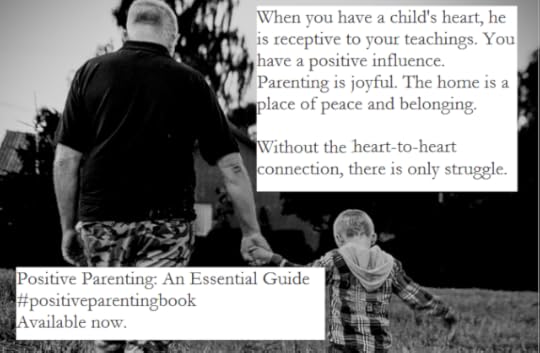
He was sitting in time-out again, tears streaming down his face, his eyes cast downward, and his chin quivering. His body was only feet away from me, but his heart was completely out of reach. I had won the battle, but at what cost? I wielded my parental authority and he knew I had power over him. He sat in the chair, defeated. I wasn't celebrating my victory, though. I'd come out on top of another power struggle, but our relationship was suffering, and both of us sat there with broken hearts. To be truthful, victory felt terrible. I longed to have the bond that we once had, my sweet baby boy and I. Oh, how I missed the joy.
And I know he missed it, too.
I had fallen into a trap. Caught in the net of societal expectations, I surrendered my inner voice. Rather than doing what I felt in my heart was right, I did what magazines, family members, and experts told me was right. Yet, it always felt so wrong. After months of daily power struggles and dampening my pillow with tears many nights, I made a decision.
This is not our story.
I looked back on the simple joy I felt when he was first placed in my arms, and I wished it wasn't so hard to reach now. I recalled his eyes, the trust and attachment reflected in them in those early months, and I noticed how his eyes had changed - now dimmed with caution and misunderstanding. My sweet, sensitive boy, have I lost your heart? The answer was yes, to a certain degree I had.
But not forever. There was still hope. There was still time to make things right.
Is this where you are today? Locked in daily power struggles? Missing the bond you once had with your child? Longing to reconnect and find the joy in parenting again?
I began searching. I knew there had to be a better way for us, and the positive parenting philosophy was the spark of hope I needed. I followed it, researching, practicing, and sharing what I was learning along the way.
The change was remarkable.
My hope is for all parents and children to experience heart-to-heart connection. Here are my top 5 tips to end the power struggles and reconnect.
1. Go into their world and stay a while. We are always pushing our rushed adult agendas on our children, so let's be mindful to pause for a beat and enter their worlds. This is where connection takes place. For small children, get down on the floor and play. Build forts or blocks. Put on a (pillowcase) cape and grab a paper towel tube sword. Play video games or watch their favorite show with them. The key is to be undistracted and to let them lead the play. Let them tell you their biggest worries and wildest dreams. Race down the slide and swing side by side. Consider adding "special time" in your nightly routine, where you lie down with each child individually and really listen.
2. Show your unwavering adoration. Kids make mistakes. Yes, even the most connected child will sometimes make a poor choice, but they need to know that nothing changes the positive view we have of them. Of course, for this to be true, they must first believe we have a positive view of them, and this requires us to be mindful of our language and tone. As Dr. Gordon Neufeld says, “Children do not experience our intentions, no matter how heartfelt. They experience what we manifest in tone and behavior.” Even during discipline, we should make it known that our love is steadfast. The message should be "I don't like what you did, but I love you always and I believe in you."
Even though I felt love for my child when we were in a cycle of constant time-outs, even though my love didn't waver, what he experienced was isolation and withdrawal of attention and warmth, and to a child, that doesn't exactly say "I love you." Yes, let them know when they are out of line. Express disappointment in their choice. Teach them how to do better. Just be aware of what they are experiencing when you're disciplining them.
Other ways to show unwavering adoration:
Show delight in them when they enter the room with a warm greeting and a smile, rather than giving an immediate demand or asking a question. Notice the positive things they do and point them out. Be the one who always sees their light and reflects it back to them.Praise effort, not outcome. He/she may have struck out on the field, but he/she showed up and played. Acknowledge the showing up.Give them the gift of undivided attention.
3. Look for the reasons behind the behavior. There was a time when I was so focused on my child's behavior, judging whether it was something that needed praised or punished, that I wasn't seeing clearly the little person behind the behavior. I missed his experience, his point of view, his feelings, and his heart. When we focus so intently on behavior modification, we can't see the whole child. Look beyond behavior to the heart of the child.
4. Offer affirming words often.
I believe in you.You can do it.I'm so glad you're mine.I'm proud of you.You really put a lot of effort into that.You're doing so well.I noticed how you ____. I appreciate that.You are my sunshine!You're fun to be around. You always make me laugh.That was so responsible of you!It isn't just about heaping on praise. It's more about helping children establish a positive attitude and belief in themselves and their goodness and capabilities. Our voices eventually become their inner voices, so do them a favor and make sure it's positive, not critical.
5. Change your aim. The goal of good parenting isn't to change a child's behavior; it's to reach his heart. Children learn best from those they feel connected to, so to have real lasting influence, the connection must be strong. When the focus is on the good you already see and on cultivating the positive characteristics you want to grow rather than on weeding out the negative, your home will naturally be a more positive, peaceful place, and parenting will be much more joyful.
I read several parenting books when making my shift to positive parenting, and I noticed that almost all of the books out there are primarily about discipline strategies and leave out the many other important aspects of raising children well. Many parents on my Facebook page told me they wanted help with getting their partners on board with positive parenting. They wanted to know how to manage their anger triggers and stop yelling. They needed positive communication skills. They longed to end the power struggles and reconnect with their kids. They wanted to change their stories.
They wanted their joy back.
Over the last 3 years, I've been working on a book that will address all of these issues. Positive Parenting: An Essential Guide is not just another discipline book. It's a book about building connected families from the ground up. It's a big-picture parenting book, because parenting is about so much more than discipline. It's releasing June 7, 2016, and if you pre-order now, you're invited to a book club! See the special offer below.
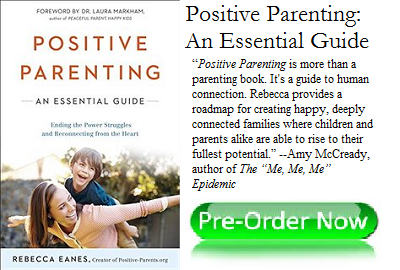
“Positive Parenting is more than a parenting book. It's a guide to human connection. Rebecca provides a roadmap for creating happy, deeply connected families where children and parents alike are able to rise to their fullest potential.” --Amy McCready, author of The “Me, Me, Me” Epidemic
To pre-order in the USA: http://bit.ly/22ezDFN...
To pre-order in Canada: http://amzn.to/1WBtjrF
To pre-order in the UK: http://bit.ly/positiveparentinguk
To pre-order from any other country: http://bit.ly/positiveparentingf

SPECIAL OFFER:
When you pre-order, you can gain access to my exclusive online book club via Facebook. In this group, you'll be able to chat with me and other parents as we read through this book together. You'll be given free PDFs that compliment the book and entered to win some sweet prizes. You'll receive the support you need to make lasting, positive changes. Just click the link below to join our book club and then send me your pre-order either through direct Facebook messaging or by emailing it to me at admin@positive-parents.org.
YES! I WANT TO JOIN THE BOOK CLUB!
Here's what people are saying about Positive Parenting: An Essential Guide:
"As I soaked up the wisdom contained in this book, two words kept coming to mind: positive pathways. No matter how challenging your family situation is or how long you’ve been going down a negative road, this book offers pathways to peace, connection, and true happiness. Through practical examples, detailed steps, and soul-stirring questions, Rebecca Eanes shows us how to reach our fullest potential as parents, partners, and human beings. Let Positive Parenting set you on a path to rewriting your story in all aspects of life, in the most positive way possible."
--Rachel Macy Stafford, New York Times-bestselling author of Hands Free Mama and Hands Free Life
“Rebecca Eanes has a deep understanding of what can hold mothers and fathers back from being the parents they want to be. Positive Parenting provides concrete tools to grow the self-discipline, connection, empathy, and techniques that will help parents (and their kids!) be their best.”
--Andrea Nair, M.A., CCC Psychotherapist, parenting educator. Creator of the Taming Tantrums App
“Watch out: Eanes' book will transform your parenting, especially if you pause to do the self-work exercises.”
--Tracy Cutchlow, author of Zero to Five
"In our always connected world of social media and Google searches there is a never-ending flow of “new and better” parenting information. It's easy to get lost in the sea of “best practices.” The focus is often on changing kids’ behavior or all the reasons you are ruining your kids. The problem is that so much of what we read seems to conflict and leaves us feeling powerless rather than truly supporting parents and families. Rebecca's new book Positive Parenting emphasizes that parenting is far more than simply making kids comply. It's about real lives, relationships, and people; It's about real moms', dads' and kids' stories and how to make those stories incredible. This book gives the reader timeless, foundational principles and practices that help to build the parent, the child and the family as a whole from the inside out."
--Andy Smithson, www.truparenting.net
“Positive Parenting beautifully illustrates the choices that modern-day parents have to raise healthy and successful children through nurturing, empathetic relationships. Bolstered by research in neuroscience and human development, Eanes shows how parents must grow alongside their children, and how this parallel journey helps young people reach their full potential. This is a must-read book for all who care enough about their children to reflect deeply on themselves as parents.”
--Marilyn Price-Mitchell, PhD, Author of Tomorrow’s Change Makers
“In this one-of-a-kind book, Rebecca Eanes goes beyond just discipline to look at the big picture of parenting. If you're longing for more in your parenting journey -- more joy, more peace, more cooperation -- I recommend Positive Parenting!”
--Jessica Alexander, co-author of The Danish Way of Parenting
“In this valuable contribution to parenting, Rebecca Eanes provides insightful, effective and practical solutions to end family conflict and build loving connections. Her masterful approach allows parents to implement powerful strategies with ease and grace, forever transforming their family life. This is a must-read for every family that yearns to create peace and harmony.”
--Dr. Shefali Tsabary, New York Times-bestselling author of The Conscious Parent
"With a belief that each parent knows their own child best and that raising children should be enjoyable, not stressful, Rebecca Eanes helps parents develop their own positive parenting blueprints to create happy, loving families. Positive Parenting helps parents work through the difficult feelings that naturally occur throughout the parenting journey and provides strategies to help raise positive thinkers."
--Katie Hurley, LCSW, author of The Happy Kid Handbook
 Rebecca Eanes, is the founder of positive-parents.org and creator of Positive Parenting: Toddlers and Beyond. She is the author of 3 books. Her newest book, Positive Parenting: An Essential Guide, will be released on June 7, 2016 and is available for pre-order now. The Newbie's Guide to Positive Parenting and a co-authored book, Positive Parenting in Action: The How-To Guide to Putting Positive Parenting Principles in Action in Early Childhood are both best-sellers in their categories on Amazon. She is the grateful mother to 2 boys.
Rebecca Eanes, is the founder of positive-parents.org and creator of Positive Parenting: Toddlers and Beyond. She is the author of 3 books. Her newest book, Positive Parenting: An Essential Guide, will be released on June 7, 2016 and is available for pre-order now. The Newbie's Guide to Positive Parenting and a co-authored book, Positive Parenting in Action: The How-To Guide to Putting Positive Parenting Principles in Action in Early Childhood are both best-sellers in their categories on Amazon. She is the grateful mother to 2 boys.
Published on May 10, 2016 08:07
May 8, 2016
Pulling Weeds: Shifting from Discipline to Nurturing the Whole Child
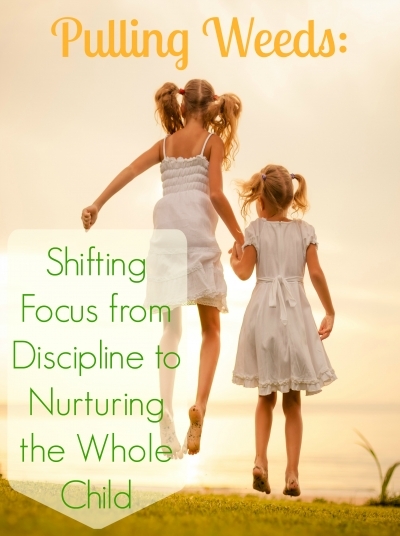 Photo credit: Creative Child Magazine
Photo credit: Creative Child MagazineRaising humans is a complex task, yet many parents hone in on one element alone – discipline. Becoming so intently focused on managing behavior narrows our picture significantly, and we lose sight, and therefore the intentions, of the many other elements that effect how our children grow.
Among these other elements are the home atmosphere and family culture we provide, our values and beliefs and how we live them out in front of our kids, the relationships we have with others in and outside of the home, the way we manage our own emotions and behavior, how we communicate both verbally and nonverbally, and the beliefs we hold about raising children and the thoughts that play over and over in our minds about our worth and theirs.
I have addressed all of this in my book, Positive Parenting: An Essential Guide , because I believe we need to broaden our view of parenting if we want to raise whole-hearted humans.
I’m not the first person to liken parenting to gardening, but I think it’s a very good analogy to make this point. To grow healthy plants, they need to be in the proper environment. They need water, air, and sun. Pulling the weeds in the garden helps to showcase the beauty of the growing plants and allows more space for them to grow.
What would happen to the plants if the gardener pulled the weeds consistently but failed to provide sunlight, water, air, or the right environment? There may be no weeds, but the plants themselves will also wither away.
And so it is with children. Correcting misbehavior is like pulling the weeds. The purpose is to allow room for the child to grow healthy and strong in character and to showcase the beauty within him, but if we aren’t providing the other elements, he, too, will wither in spirit. The plant’s potential will never be realized without tender care and the proper nutrients, and the same is true for a child.
How to Grow a Human:
Provide the Right Environment
1. Safe for Play:Set up a “yes” environment by properly child-proofing common areas so that your child can freely and safely explore. Keep it simple, organized, and clutter-free. Intentionally choose play things that are engaging and provide the right amount of challenge. Provide open ended toys and materials so the child can freely create and pretend, and also include sensory items like play dough, paint, and sensory bins .
2. Emotionally Safe: In an emotionally safe environment, children are both free to express their emotions while being taught how to express them emotionally and are free from emotional assault by parents, siblings, or others by means of shaming, teasing, put-downs, etc. Set firm boundaries on how siblings are allowed to treat each other and don’t wave off teasing and name calling as “normal sibling behavior.”
3. Physically Safe: Physical discipline is not only unnecessary but often damaging. If you need alternatives, click here .
4. Family Culture: The home environment should be calm and inviting, so constant tension or stress needs to be addressed and resolved. Create and keep meaningful family traditions and rituals and use positive communication skills .
Give Them the Sun
Your example is their guiding light. The way you manage your emotions, handle disappointment and failure, maintain composure during difficult situations, choose joy, see the positive, and act toward them and others teaches them more than all the lectures they’ll ever hear.
Affirmation is Like Rain
Best-selling author, L. R. says, “Words of recognition and appreciation to a child are like sunshine and rain to a flower.”
Speak words of life to them. Express your belief often that they have an amazing future, and that they are good, kind, and capable.Thank them when they are helpful. Catch them being good and verbalize your appreciation for that.Acknowledge their heart. Show them you know they have good intentions, even if they made a mistake in judgement. Praise them genuinely and specifically.Let them hear you say nice things about them to others. Unconditional Love is a Breath of Fresh Air
Children need close attachment with us. They need to feel connected. Threatening to withdraw warmth, attention, or presence in the name of discipline causes them to enter a state of unrest. Even though our love is always unconditional, kids don’t perceive it that way if we withdraw from them.
When we can provide rest – a state of knowing they are safe in our love and attachment and that nothing can separate them from our love – they are free to grow. Dr. Gordon Neufeld says, “All growth emanates from a place of rest” and that “children must never work for our love; they must rest in it.” See his full video on this here .
Let’s widen our lens and look at the big picture of parenting so that we can grow a happier, healthier generation of humans.
This post was originally published at Creative Child Magazine.
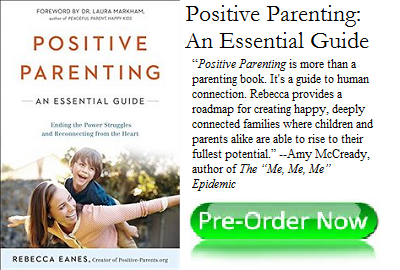
 Rebecca Eanes, is the founder of positive-parents.org and creator of Positive Parenting: Toddlers and Beyond. She is the author of 3 books. Her newest book, Positive Parenting: An Essential Guide, will be released on June 7, 2016 and is available for pre-order now. The Newbie's Guide to Positive Parenting and a co-authored book, Positive Parenting in Action: The How-To Guide to Putting Positive Parenting Principles in Action in Early Childhood are both best-sellers in their categories on Amazon. She is the grateful mother to 2 boys.
Rebecca Eanes, is the founder of positive-parents.org and creator of Positive Parenting: Toddlers and Beyond. She is the author of 3 books. Her newest book, Positive Parenting: An Essential Guide, will be released on June 7, 2016 and is available for pre-order now. The Newbie's Guide to Positive Parenting and a co-authored book, Positive Parenting in Action: The How-To Guide to Putting Positive Parenting Principles in Action in Early Childhood are both best-sellers in their categories on Amazon. She is the grateful mother to 2 boys.
Published on May 08, 2016 08:35
May 3, 2016
The Parenting Stuff We Don't Talk About

Parenting is extremely complex, but we've tried for a long time to simplify it into discipline choices. We're told if we discipline a certain way, our kids will learn good behavior and ultimately turn out just fine.
But parenting is about so much more than just discipline.
At it's core, parenting is about relationships, and in our search for the perfect discipline tricks, we've lost sight of that. We are trained to ask "what do I do when my child...." rather than "how can I help this little person whom I love so much." We are fed study after study and opinion after opinion on the proper and least damaging way to discipline children, so it's no wonder that becomes our main focus.
But when discipline becomes our main focus, we neglect the bigger picture. Many of the other important aspects of parenting fall by the wayside as we mindfully, purposefully, intentionally focus on disciplining correctly.
I think it's time we broaden our lens. Let's back up and look at parenting in a new way - a much bigger way.
Let's Talk About Stories:
Parenting is a mixing of stories. Mom's story, Dad's story, brother's story and sister's story. Grandparents' stories and cultural stories. Media stories and unconscious stories.
And because you are holding the pen that writes the beginning of your little one's life story, it's smart to take a pause and look at your story first - look to see what is influencing the pen in your hand. What are your beliefs and where do they come from? Is your partner's beliefs about parenting in line with yours? What feeds your thoughts? What triggers your reactions? These things matter because they are at the heart of how you see and treat your children.
Let's Talk About Self-Control
What kind of example are we setting? Do we demand our children behave one way while we act in the opposite? Are we regularly losing it? You know that who we are and how we behave teaches so much more than what we say. It's time to talk about self-control.
Let's Talk About Our Marriages and Partnerships
Chances are there is somebody else involved in raising your child. Do you agree on parenting or are you polar opposites? Is this issue cause for contention in your relationship and in your home? Let's address it. Face it head on and get on the same page. It matters.
Let's Talk About Communication
Respectful, positive communication is important in growing strong, connected families. How do you communicate with your partner? Your kids? Positive, effective communication helps us understand one another, avoid conflict, and connect. It keeps us engaged in each other's lives.
Let's Talk About Trust
As I said, parenting is about relationships. A good parent-child relationship is built on a foundation of trust. How do we foster trust? How do we keep it strong as our children grow through various stages?
Building trust with an infant obviously looks much different than building trust with a tween. What if trust has been broken? How do you get it back?
Let's Talk About Family Culture
This is such a big topic. The atmosphere and family experience you provide is the world your child grows up in. It shapes her view of everything, including her self-worth. It influences her heart and mind every day, but many of us just allow our family culture to come together sort of haphazardly, without much intention or forethought, because our focus is elsewhere. Let's talk about your vision, your goals, your routines, and your traditions. This is what childhoods are made of.
Let's Talk About How We See Children
Take a look at cultural ideas and "truths" we've accepted and live by. Take a look at how this influences your parenting decisions. Let's challenge them to see if they're serving us well.
Let's Talk About Positive Discipline
Yes, discipline is an important factor, and it's good to learn positive tools that teach your children good values and skills while keeping hold of their hearts.
You will find all of this and more in my new one-of-a-kind parenting book, Positive Parenting: An Essential Guide.
CLICK HERE TO PRE-ORDER
“Positive Parenting is more than a parenting book. It's a guide to human connection. Rebecca provides a roadmap for creating happy, deeply connected families where children and parents alike are able to rise to their fullest potential.” --Amy McCready, author of The “Me, Me, Me” Epidemic
To pre-order in the USA: http://bit.ly/22ezDFN...
To pre-order in Canada: http://amzn.to/1WBtjrF
To pre-order in the UK: http://bit.ly/positiveparentinguk
To pre-order from any other country: http://bit.ly/positiveparentingf
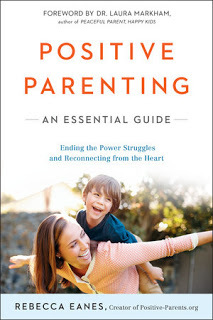
SPECIAL OFFER:
When you pre-order, you can gain access to my exclusive online book club via Facebook. In this group, you'll be able to chat with me and other parents as we read through this book together. You'll be given free PDFs that compliment the book and entered to win some sweet prizes. Just click the link below to join our book club and then send me your pre-order either through direct Facebook messaging or by emailing it to me at admin@positive-parents.org.
YES! I WANT TO JOIN THE BOOK CLUB!
Here's what people are saying about Positive Parenting: An Essential Guide:
"As I soaked up the wisdom contained in this book, two words kept coming to mind: positive pathways. No matter how challenging your family situation is or how long you’ve been going down a negative road, this book offers pathways to peace, connection, and true happiness. Through practical examples, detailed steps, and soul-stirring questions, Rebecca Eanes shows us how to reach our fullest potential as parents, partners, and human beings. Let Positive Parenting set you on a path to rewriting your story in all aspects of life, in the most positive way possible."
--Rachel Macy Stafford, New York Times-bestselling author of Hands Free Mama and Hands Free Life
“Rebecca Eanes has a deep understanding of what can hold mothers and fathers back from being the parents they want to be. Positive Parenting provides concrete tools to grow the self-discipline, connection, empathy, and techniques that will help parents (and their kids!) be their best.”
--Andrea Nair, M.A., CCC Psychotherapist, parenting educator. Creator of the Taming Tantrums App
“Watch out: Eanes' book will transform your parenting, especially if you pause to do the self-work exercises.”
--Tracy Cutchlow, author of Zero to Five
"In our always connected world of social media and Google searches there is a never-ending flow of “new and better” parenting information. It's easy to get lost in the sea of “best practices.” The focus is often on changing kids’ behavior or all the reasons you are ruining your kids. The problem is that so much of what we read seems to conflict and leaves us feeling powerless rather than truly supporting parents and families. Rebecca's new book Positive Parenting emphasizes that parenting is far more than simply making kids comply. It's about real lives, relationships, and people; It's about real moms', dads' and kids' stories and how to make those stories incredible. This book gives the reader timeless, foundational principles and practices that help to build the parent, the child and the family as a whole from the inside out."
--Andy Smithson, www.truparenting.net
“Positive Parenting beautifully illustrates the choices that modern-day parents have to raise healthy and successful children through nurturing, empathetic relationships. Bolstered by research in neuroscience and human development, Eanes shows how parents must grow alongside their children, and how this parallel journey helps young people reach their full potential. This is a must-read book for all who care enough about their children to reflect deeply on themselves as parents.”
--Marilyn Price-Mitchell, PhD, Author of Tomorrow’s Change Makers
“In this one-of-a-kind book, Rebecca Eanes goes beyond just discipline to look at the big picture of parenting. If you're longing for more in your parenting journey -- more joy, more peace, more cooperation -- I recommend Positive Parenting!”
--Jessica Alexander, co-author of The Danish Way of Parenting
“In this valuable contribution to parenting, Rebecca Eanes provides insightful, effective and practical solutions to end family conflict and build loving connections. Her masterful approach allows parents to implement powerful strategies with ease and grace, forever transforming their family life. This is a must-read for every family that yearns to create peace and harmony.”
--Dr. Shefali Tsabary, New York Times-bestselling author of The Conscious Parent
"With a belief that each parent knows their own child best and that raising children should be enjoyable, not stressful, Rebecca Eanes helps parents develop their own positive parenting blueprints to create happy, loving families. Positive Parenting helps parents work through the difficult feelings that naturally occur throughout the parenting journey and provides strategies to help raise positive thinkers."
--Katie Hurley, LCSW, author of The Happy Kid Handbook
Published on May 03, 2016 08:49
May 2, 2016
49 Phrases to Calm an Anxious Child
49 Phrases to Calm an Anxious Child
Written by Renee Jain, Chief Storyteller at GoZen! Anxiety Relief for Kids
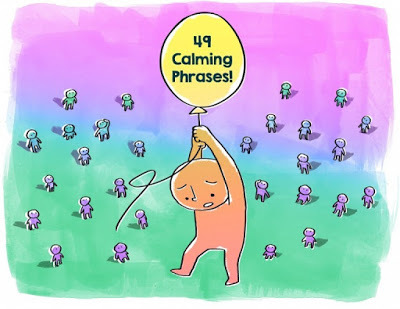
It happens to every child in one form or another – anxiety. As parents, we would like to shield our children from life’s anxious moments, but navigating anxiety is an essential life skill that will serve them in the years to come. In the heat of the moment, try these simple phrases to help your children identify, accept, and work through their anxious moments.
1. “Can you draw it?”
Drawing, painting or doodling about an anxiety provides kids with an outlet for their feelings when they can’t use their words.
2. “I love you. You are safe.”
Being told that you will be kept safe by the person you love the most is a powerful affirmation. Remember, anxiety makes your children feel as if their minds and bodys are in danger. Repeating they are safe can soothe the nervous system.
3. “Let’s pretend we’re blowing up a giant balloon. We’ll take a deep breath and blow it up to the count of 5.”
If you tell a child to take a deep breath in the middle of a panic attack, chances are you’ll hear, “I CAN’T!” Instead, make it a game. Pretend to blow up a balloon, making funny noises in the process. Taking three deep breaths and blowing them out will actually reverse the stress response in the body and may even get you a few giggles in the process.
4. “I will say something and I want you to say it exactly as I do: ‘I can do this.’” Do this 10 times at variable volume.
Marathon runners use this trick all of the time to get past “the wall.”
5. “Why do you think that is?”
This is especially helpful for older kids who can better articulate the “Why” in what they are feeling.
6. “What will happen next?”
If your children are anxious about an event, help them think through the event and identify what will come after it. Anxiety causes myopic vision, which makes life after the event seem to disappear.
7. “We are an unstoppable team.”
Separation is a powerful anxiety trigger for young children. Reassure them that you will work together, even if they can’t see you.
8. Have a battle cry: “I am a warrior!”; “I am unstoppable!”; or “Look out World, here I come!”
There is a reason why movies show people yelling before they go into battle. The physical act of yelling replaces fear with endorphins. It can also be fun.
9. “If how you feel was a monster, what would it look like?”
Giving anxiety a characterization means you take a confusing feeling and make it concrete and palpable. Once kids have a worry character, they can talk to their worry.
10. “I can’t wait until _____.”
Excitement about a future moment is contagious.
11. “Let’s put your worry on the shelf while we _____ (listen to your favorite song, run around the block, read this story). Then we’ll pick it back up again.”
Those who are anxiety-prone often feel as though they have to carry their anxiety until whatever they are anxious about is over. This is especially difficult when your children are anxious about something they cannot change in the future. Setting it aside to do something fun can help put their worries into perspective.
12. “This feeling will go away. Let’s get comfortable until it does.”
The act of getting comfortable calms the mind as well as the body. Weightier blankets have even been shown to reduce anxiety by increasing mild physical stimuli.
13. “Let’s learn more about it.”
Let your children explore their fears by asking as many questions as they need. After all, knowledge is power.
14. “Let’s count _____.”
This distraction technique requires no advance preparation. Counting the number of people wearing boots, the number of watches, the number of kids, or the number of hats in the room requires observation and thought, both of which detract from the anxiety your child is feeling.
15. “I need you to tell me when 2 minutes have gone by.”
Time is a powerful tool when children are anxious. By watching a clock or a watch for movement, a child has a focus point other than what is happening.
16. “Close your eyes. Picture this…”
Visualization is a powerful technique used to ease pain and anxiety. Guide your child through imagining a safe, warm, happy place where they feel comfortable. If they are listening intently, the physical symptoms of anxiety will dissipate.
17. “I get scared/nervous/anxious sometimes too. It’s no fun.”
Empathy wins in many, many situations. It may even strike up a conversation with your older child about how you overcame anxiety.
18. “Let’s pull out our calm-down checklist.”
Anxiety can hijack the logical brain; carry a checklist with coping skills your child has practiced. When the need presents itself, operate off of this checklist.
19. “You are not alone in how you feel.”
Pointing out all of the people who may share their fears and anxieties helps your child understand that overcoming anxiety is universal.
20. “Tell me the worst thing that could possibly happen.”
Once you’ve imagined the worst possible outcome of the worry, talk about the likelihood of that worst possible situation happening. Next, ask your child about the best possible outcome. Finally, ask them about the most likely outcome. The goal of this exercise is to help a child think more accurately during their anxious experience.
21. “Worrying is helpful, sometimes.”
This seems completely counter-intuitive to tell a child that is already anxious, but pointing out why anxiety is helpful reassures your children that there isn’t something wrong with them.
22. “What does your thought bubble say?”
If your children read comics, they are familiar with thought bubbles and how they move the story along. By talking about their thoughts as third-party observers, they can gain perspective on them.
23. “Let’s find some evidence.”
Collecting evidence to support or refute your child’s reasons for anxiety helps your children see if their worries are based on fact.
24. “Let’s have a debate.”
Older children especially love this exercise because they have permission to debate their parent. Have a point, counter-point style debate about the reasons for their anxiety. You may learn a lot about their reasoning in the process.
25. “What is the first piece we need to worry about?”
Anxiety often makes mountains out of molehills. One of the most important strategies for overcoming anxiety is to break the mountain back down into manageable chunks. In doing this, we realize the entire experience isn’t causing anxiety, just one or two parts.
26. “Let’s list all of the people you love.”
Anais Nin is credited with the quote, “Anxiety is love’s greatest killer.” If that statement is true, then love is anxiety’s greatest killer as well. By recalling all of the people that your child loves and why, love will replace anxiety.
27. “Remember when…”
Competence breeds confidence. Confidence quells anxiety. Helping your children recall a time when they overcame anxiety gives them feelings of competence and thereby confidence in their abilities.
28. “I am proud of you already.”
Knowing you are pleased with their efforts, regardless of the outcome, alleviates the need to do something perfectly – a source of stress for a lot of kids.
29. “We’re going for a walk.”
Exercise relieves anxiety for up to several hours as it burns excess energy, loosens tense muscles and boosts mood. If your children can’t take a walk right now, have them run in place, bounce on a yoga ball, jump rope or stretch.
30. “Let’s watch your thought pass by.”
Ask your children to pretend the anxious thought is a train that has stopped at the station above their head. In a few minutes, like all trains, the thought will move on to its next destination.
31. “I’m taking a deep breath.”
Model a calming strategy and encourage your child to mirror you. If your children allow you, hold them to your chest so they can feel your rhythmic breathing and regulate theirs.
32. “How can I help?”
Let your children guide the situation and tell you what calming strategy or tool they prefer in this situation.
33. “This feeling will pass.”
Often, children will feel like their anxiety is never-ending. Instead of shutting down, avoiding, or squashing the worry, remind them that relief is on the way.
34. “Let’s squeeze this stress ball together.”
When your children direct their anxiety to a stress ball, they feel emotional relief. Buy a ball, keep a handful of play dough nearby or make your own homemade stress ball by filling a balloon with flour or rice.
35. “I see Widdle is worried again. Let’s teach Widdle not to worry.”
Create a character to represent the worry, such as Widdle the Worrier. Tell your child that Widdle is worried and you need to teach him some coping skills.
36. “I know this is hard.”
Acknowledge that the situation is difficult. Your validation shows your children that you respect them.
37. “I have your smell buddy right here.”
A smell buddy, fragrance necklace or diffuser can calm anxiety, especially when you fill it with lavender, sage, chamomile, sandalwood or jasmine.
38. “Tell me about it.”
Without interrupting, listen to your children talk about what’s bothering them. Talking it out can give your children time to process their thoughts and come up with a solution that works for them.
39. “You are so brave!”
Affirm your children’s ability to handle the situation, and you empower them to succeed this time.
40. “Which calming strategy do you want to use right now?”
Because each anxious situation is different, give your children the opportunity to choose the calming strategy they want to use.
41. “We’ll get through this together.”
Supporting your children with your presence and commitment can empower them to persevere until the scary situation is over.
42. “What else do you know about (scary thing)?”
When your children face a consistent anxiety, research it when they are calm. Read books about the scary thing and learn as much as possible about it. When the anxiety surfaces again, ask your children to recall what they’ve learned. This step removes power from the scary thing and empowers your child.
43. “Let’s go to your happy place.”
Visualization is an effective tool against anxiety. When your children are calm, practice this calming strategy until they are able to use it successfully during anxious moments.
44. “What do you need from me?”
Ask your children to tell you what they need. It could be a hug, space or a solution.
45. “If you gave your feeling a color, what would it be?”
Asking another person to identify what they’re feeling in the midst of anxiety is nearly impossible. But asking your children to give how they feel with a color, gives them a chance to think about how they feel relative to something simple. Follow up by asking why their feeling is that color.
46. “Let me hold you.”
Give your children a front hug, a hug from behind, or let them sit on your lap. The physical contact provides a chance for your child to relax and feel safe.
47. “Remember when you made it through XYZ?”
Reminding your child of a past success will encourage them to persevere in this situation.
48. “Help me move this wall.”
Hard work, like pushing on a wall, relieves tension and emotions. Resistance bands also work.
49. “Let’s write a new story.”
Your children have written a story in their mind about how the future is going to turn out. This future makes them feel anxious. Accept their story and then ask them to come up with a few more plot lines where the story’s ending is different.
Have an anxious child? Visit GoZen! for engaging anxiety relief animations for your child.
Bio:

Renee Jain is an award-winning tech entrepreneur turned speaker and certified life coach. She holds a masters in applied positive psychology from the University of Pennsylvania. Renee’s passion is taking research-based concepts and transforming them into fun and digestible learning modules. Renee teaches anxious children how to manage stress and worry through her innovative GoZen! Anxiety Relief Programs for Kids.
Published on May 02, 2016 08:33



